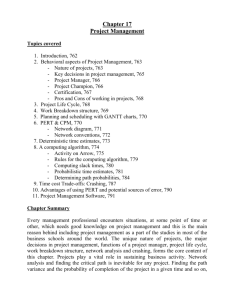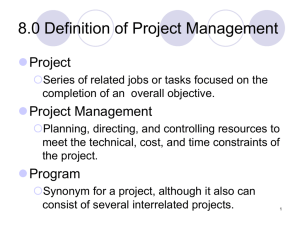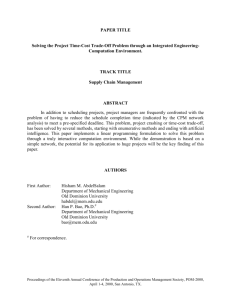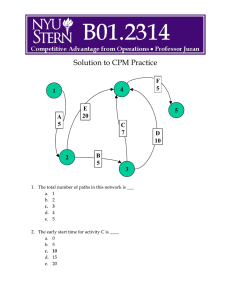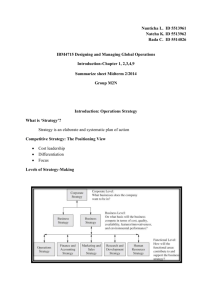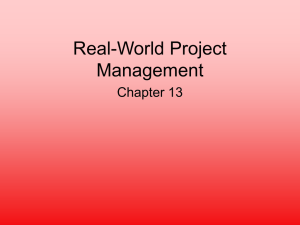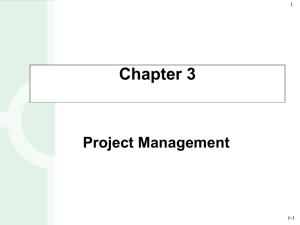OP5 - Providence University College
advertisement
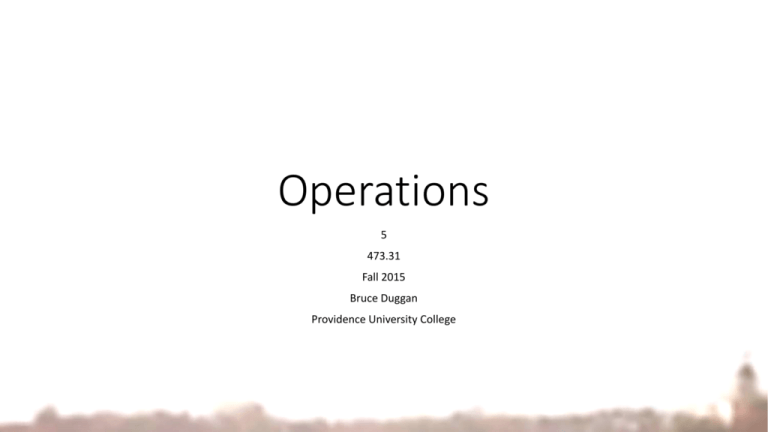
Operations 5 473.31 Fall 2015 Bruce Duggan Providence University College Summary Want to understand: • the different organizational structures of projects • the purpose of a work breakdown structure • the uses of a critical path • how projects can be shortened through the use of crashing concepts 5-29 Key Questions What is project management? How would you assess a partially completed project that to date has spent more than planned but has accomplished more work than planned? What are the three ways a project can be structured within an organization? Which path is the critical path for a project? Can there be more than one? What is the correct hierarchy for: How can I determine the probability of completing a project on time when I’m not sure how long the activities will take? • a task • a program • a work package • a project • a subtask? If we have to speed up a project, which activity is the best one to assign more resources to? 5-28 LO1 Project Management Definitions A Project is a series of related jobs usually directed toward some major output and requiring a significant period of time to perform Project Management refers to the management activities of planning, directing, and controlling resources (people, equipment, material) to meet the technical, cost, and time constraints of a project LO2 Types of Project Organization Structures Pure Project • a structure for organizing a project where a self-contained team works fulltime on a project Functional Project • a structure where team members are assigned from functional units of the organization Matrix Project • is a structure that blends the functional and pure project structures LO2 Pure Project Advantages: • project manager has full authority over the project • team members report to one boss • lines of communication are shortened • team pride, motivation, and commitment are high Disadvantages: • duplication of resources • organizational goals and policies ignored • lack of technology transfer. • team members have no functional area “home” Functional Project A functional project is housed within a functional division. Functional Project Advantages: • team member can work on several projects • technical expertise is maintained within a functional area • functional area is a “home” after project is completed • there’s a critical mass of specialized knowledge Disadvantages: • aspects of the project not directly related to the functional area get short-changed • motivation of team members is often weak • needs of the client are secondary and are responded to slowly Matrix Project blends properties of functional and pure project structures Matrix Project Advantages: • communication between functional divisions enhanced. • a project manager is held responsible for successful completion of the project • team members have a functional home after the project completion • policies of the parent organization are followed Disadvantages: • there are two bosses • project may be doomed to failure unless the project manager has strong negotiation skills • suboptimization is a danger Work Breakdown Structure Work breakdown structure = the hierarchy of project tasks, subtasks, and work packages. • Task is a further subdivision of a project. • Subtask further divides the project into more meaningful pieces. • Work package is a group of activities to be assignable to a single organizational unit. 5-10 Work Breakdown Structure Project Control Charts Tracking Progres Gantt Chart Activity 1 Activity 2 Activity 3 Activity 4 Activity 5 Activity 6 time horizontal axis is always time Earned Value Management Network-Planning Models • a project is made up of a sequence of activities that form a network • the path taking longest time through this network of activities is called the “critical path” • the critical path provides a wide range of scheduling information useful in managing a project • Critical Path Method (CPM) helps to identify the critical path(s) in the project networks 5-15 Types of Network Planning Models Critical Path Method (CPM) • used when activity times are known with certainty • used to determine • timing estimates for the project • Time estimates for each activity in the project Time-Cost Models • used when cost trade-off information is a major consideration in planning • used to determine the least cost in reducing total project time • slack time for activities 5-16 Critical Path Method (CPM) 1. Identify each activity to be done in the project • and estimate how long it will take to complete 2. Determine the required sequence of activities • and construct a network reflecting the precedence relationships 3. Determine the critical path 4. Determine the schedule with, for each activity: • • • • early start early finish late start late finish 5-17 Critical Path Method (CPM) 1. Identify each activity to be done in the project • and estimate how long it will take to complete task Stock Analysis A. Select a company. B. Obtain the company’s annual report and perform a ratio analysis. C. Collect technical stock price data and construct charts. D. Individually review the data and make a decision on whether to buy the stock. 5-17 Critical Path Method Example 2. Determine the required sequence of activities • and construct a network reflecting the precedence relationships Critical Path Method Example 3. Determine the critical path 5-20 Critical Path Method Example 4. Determine the schedule with, for each activity: • early start • early finish • late start • late finish 5-21 Critical Path Method Example 4. Determine the schedule with, for each activity: • early start • early finish • late start • late finish 5-22 Activity Time Uncertainty Time-Cost (Crash) Models Extension of CPM that considers the trade-off between the time required to complete an activity and cost. • Referred to as “crashing” the project. Crashing Process: 1. Prepare a CPM-type diagram. 2. Determine the cost per unit of time to expedite each activity. 3. Compute the critical path. 4. Shorten the critical path at the least cost. 5. Plot project direct, indirect, and total-cost curves and find the minimum-cost schedule. Time-Cost Trade-Off Procedure 5-25 Time-Cost Trade-Off Procedure 5-26 Time-Cost Trade-Off Procedure 5-27 End of Chapter 5
